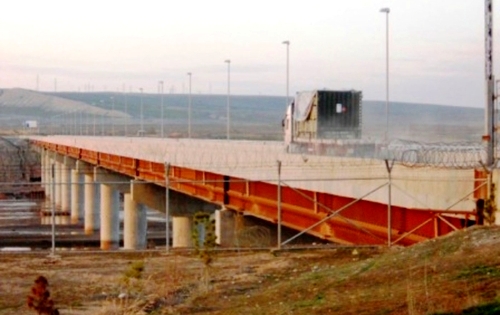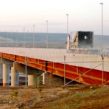
Chinese-Built Tunnel Projects in Tajikistan Could Bolster KKT Route of NATO’s NDN
Publication: Eurasia Daily Monitor Volume: 9 Issue: 142
By:

On July 11, the excavation of the Shahristan tunnel connecting northern and southern Tajikistan was completed. When opened, the 5,253-meter-long tunnel will reduce travel time between Dushanbe and Khujand by two hours (BBC Tajik, July 11). More importantly, the tunnel will make the route safer and more reliable in the winter and spring months. Currently, vehicles must cross the 3,345-meter snow-covered Shahristan pass, which is subject to regular avalanches and mudslides that claim dozens of lives each year. According to Rustam Abdulloev, deputy director for the Dushanbe-Khujand-Chanok highway project (DKC), currently workers are using the tunnel, but it will not officially be opened until September 25 (BBC Tajik, July 11). The DKC serves as a vital trade artery connecting the capital of Dushanbe to the economically vital Sughd province and the Ferghana Valley. The project, which began in 2006 under the management of the Chinese company “China Road,” is financed by a $296 million loan from the Chinese government. The projected cost of the tunnel is $80 million (Nahzat, July 13).
The completion of the DKC not only has implications for domestic economic integration and Sino-Tajik relations, but also potential ramifications for NATO’s Northern Distribution Network (NDN) and the US vision for a “New Silk Road” in the region. Approximately, 70 percent of cargo transiting the NDN enters through Uzbekistan’s Hairaton Gate, but Tajikistan has the potential to play a greater role in the NDN (see EDM, April 16). Currently the only part of the NDN that goes through Tajikistan is the Kazakhstan-Kyrgyzstan-Tajikistan route (KKT), managed by the Washington DC-based firm FMN Logistics (Avesta, July 4). Cargo travelling along this route enters Tajikistan on trucks from Kyrgyzstan via the Sarytash-Karamyk crossing and proceeds to Afghanistan via a US built bridge at the Nizhny Panj-Sher Khan Bandar border crossing (https://fmnlogistics.com/static.php?content_id=26).
On February 29, a group of twenty 25-ton trucks owned by FMN took the first retrograde trip from Afghanistan along the KKT route (BBC Tajik, March 5). In his testimony to Congress, newly appointed Ambassador to Tajikistan Susan Elliot commented on the KKT saying, “The capacity is not great because we have to truck things through the mountains of Tajikistan; however, we’ve had a very good success rate with very low loss of cargo, no pilferage, and we’ve gotten a lot of cooperation from the government of Tajikistan on that” (Avesta, July 4). In previous remarks at the Northern Distribution Network Conference on May 8, 2012, she noted that, to date, more than 66,000 containers of material have been shipped to Afghanistan via the NDN, and the infrastructure being developed for this route is helping to advance America’s vision for the New Silk Road policy for South and Central Asian integration that was announced last year (https://www.state.gov/p/sca/rls/rmks/2012/189499.htm; also see “Central Asia, Afghanistan and the New Silk Road Conference Report,” Jamestown Foundation, November 14, 2011).
Currently, the Tajikistani section of the NDN does not utilize the DKC highway; however, with the completion of the Shahristan tunnel, this may change. The highway with its two tunnels that bypass the high Anzob and Shahristan mountain passes would help mitigate complications caused by mountainous terrain. It should also be noted that the current KKT route goes through the heart of the Rasht Valley, an unstable region that has seen periodic violence in the last few years (see EDM, September 29, 2010). In the event of renewed fighting in the region, the newly reconstructed DKC highway provides redundancy and an alternative route through a more politically stable part of the country. In addition to Chinese-funded road projects, last year Japan pledged $24 million to refurbish roads in Khatlon province in southern Tajikistan, and Kyrgyzstan has invested in a 136-kilometer section of road on the Sarytash-Karamyk border crossing along the KKT route (BBC Tajik, December 12, https://piumotc.kg/en/sarytash-karamyk/).
Although the DKC highway promises greater economic integration in Tajikistan, a controversial decision to make it a toll road in 2010 has caused domestic discontent. Local journalists and pundits complain of a lack of transparency concerning the company that manages the toll system – Innovative Road Solutions (IRS). Many complain that in spite of paying relatively high tolls, this revenue is not reinvested toward necessary road maintenance and repairs, but rather goes directly into the pocket of the company president or one of his relatives. An internal power struggle has also developed between the traffic police (GAI) and the IRS. According to the agreement between the IRS and the Tajikistani government, the establishment of GAI posts on the road is banned, which deprives them of a lucrative source of bribes (Ozodi, June 28).
While the NDN plays an important role in the United States’ Silk Road strategy and gives NATO leverage over Pakistan’s de facto monopoly on transit, some experts point to the potential downside of the NDN. Among them are increased costs, potential for corruption, rivalry amongst Central Asian countries for lucrative transit deals, and drug trafficking. Fears of the later have caused some pundits to joke that the so-called “New Silk Road” could be more aptly named the “New Heroin Highway.” Aware of these concerns, a large part of US and European assistance to Tajikistan is allocated to strengthen border security and combat drug trafficking. Furthermore, according to Bill Speaks, a Defense Department spokesman, collectively Central Asian states receive approximately $500 million per year in transit fees (state by state figures are not publicly available) and noted that the cost-per-container for NDN cargo is approximately $10,000 more than via the Pakistani route (https://www.eurasianet.org/node/64617).
However, US policy in Tajikistan is not limited to the NDN. A recent series of high-level meetings between US and Tajikistani officials has highlighted the increased cooperation between the two countries. On July 4, Representative Dan Burton, the chairman for the Foreign Relations Subcommittee on Europe and Eurasia, led a congressional delegation to the region. The US delegation’s members met with the leaders of all five Central Asian states. During the three-day visit to Dushanbe, Burton met with President Emomalii Rahmon and the topic of establishing a US base was raised (Ozodi, July 6). Representative Burton was quoted as saying, “It’s planned that after the withdrawal of NATO troops from Afghanistan in 2014 that America’s ‘Manas’ base in Kyrgyzstan will be closed. We are not speaking on behalf of the administration; however, we believe that given Tajikistan’s long border with Afghanistan it could serve as a replacement for this transit center” (Ozodi, July 6). Additionally, on July 17, a US National Security Council delegation led by Alice Wells met with President Rahmon and discussed increasing bilateral security cooperation (Ozodi, July 17).
While there is no doubt that Tajikistan will play an increasing role both in the NDN and the US policy toward stabilizing Afghanistan in the years to come, some local experts doubt that the United States will be granted basing rights. The timing of the recent US delegations coincided with two key events: 1) Uzbekistan’s decision to leave the CSTO and 2) heated negotiations between Moscow and Dushanbe over Russian basing rights in Tajikistan (see EDM, July 9, July 18). The latter has caused experts to speculate that recent meetings between US and Tajikistani officials had more to do with political theater designed to strengthen Dushanbe’s negotiating position vis-à-vis Russia. However, given Tajikistan’s multi-vector foreign policy and rivalry with Uzbekistan, it is not unlikely that they will increasingly vie for a greater piece of the NDN and foreign assistance pie created by the 2014 NATO withdrawal from Afghanistan.




